Содержание
- 2. Robots from Colorado State University Year Finishes Machine 1986-87 3rd Place 1987-88 1st Place Lurch 1988-89
- 3. Design of a Rough Terrain Vehicle (RTV)
- 4. LEGO Parts Kits 5201 Connectors 5228/5235 Frame Members 5267 Shafts, Rigid Couplings 5269 Bell Cranks, Misc.
- 5. LEGO Parts Kits 9854 Rack & Pinion Gears 9965 Two sizes, small spur gears 9966 Two
- 6. Gear/Motor Fundamentals Spur gears have straight teeth Used to transmit torque and rotation between parallel shafts
- 7. Gear Fundamentals Torque times angular velocity is constant between two meshed gears Angular velocity ratio between
- 8. Simple Gear Trains A Simple Gear Train has one gear per shaft- each shaft rotates in
- 9. Compound Gear Trains A Compound Gear Train has more than one gear on at least one
- 10. Worm Gear & Worm
- 11. Rack & Pinion
- 12. Straight Bevel Gears
- 13. Measuring Legged Locomotion Walking is similar to rolling a polygon which has the center located at
- 14. Power Required to Walk Work required to walk is wasted in the consecutive lifting and falling
- 16. Great History Moments in Legged Locomotion 1837 Weber and Weber Measure corpses and show that natural
- 17. The Mechanical Horse Device patented by Lewis Rygg in 1893 The stirrups double as pedals so
- 18. Linkage Fundamentals Linkages are levers of various shapes joined together by joints which form the basic
- 19. Linkage Fundamentals Linkages are normally driven by a short lever This level is also called a
- 20. What is a pivot? A short rod or shaft about which a related part rotates or
- 21. Generating Walking When input crank AB rotates, – 1/2 straight path and 1/2 arched path. Linkages
- 22. What are the types of mechanism chains? Linkages are levers of various shapes joined together by
- 23. Crank & Rocker Rocker Pivot Grashof Crank - Rocker rotates Extreme positions This symbol means it
- 24. Rules For Link Lengths Long +Short Links Crank & Rocker When Short Link is Crank Double
- 25. Walking-Link Crank & Rocker A four-bar linkage Triangular extension which supports a shoe which can pivot
- 26. Equal Link Lengths On Opposite Sides Equal length
- 27. Hexapod Six-Legged Robot
- 28. Another Hexapod
- 29. Walking Plates
- 30. More Great History Moments 1983 Odetics demonstrates a self-contained hexapod which lifts and moves back end
- 31. Two Legged Vehicle--The P2 Honda Motor Co. Obstacle Avoidance by stepping over and around. can walk
- 32. Hexapods from Lynxmotion
- 33. Lynxmotion Kits Hexapods Cars Arms Quadrupeds Lynxmotion Hexapods
- 34. Basic Radio-Controlled Spider Hexapod with Gripper
- 35. Spider with a camera
- 37. The Hexapod Kit Hexapod II Kit (body and 12 servos) A next step micro controller with
- 38. Added Wireless Video Camera Called the XCAM2 Purchased from X10.com It costs $99.99 with a battery
- 39. Basic Stamp2-SX controller Microcontroller: Scenix SX28AC Program execution speed: 10,000 instructions per second Processor Speed: 50
- 40. Controller continued… Inputs/Outputs: 16 + 2 dedicated serial I/O Current @ 5v: 60mA Run / 200
- 41. Next Step Carrier Board Basic stamp 2-sx module plugs into the Next Step Microcontroller Supplies: Serial
- 42. Component Interconnections The Next Step has the Basic Stamp 2 module on it Other components are
- 43. Serial LCD Display Power, ground and a single data connection Serial information is sent via the
- 44. IRPD IRPD = Infra Red Proximity Detector Connected to power and ground Three I/O ports: Left
- 45. Infra Red Proximity Detector
- 46. MiniSSCII servo controller Receives serial data: Which servo Move to what position Control 8 servos per
- 47. Hexapod II Configuration Two MiniSSCIIs working together Six servos per controller: one controller: 0 to 5
- 48. Servos Components: Electric motor Gearing Potentiometer Difference amplifier Power amplifier
- 49. Servo Operation Potentiometer measures output shaft position Input signal is sent in Difference amplifier compares values
- 50. Pulse Width Modulation When “high” for 2mS, stays in right By controlling the pulse width you
- 51. Notable Features Variable speed Input signal is pulse width modulation Pulses ranging from 1 to 2
- 52. Batteries & Switches 9 volt battery for the next step 9 volt battery for the MiniSSCII
- 57. Programming PBasic programming language Syntax described in book Provided text editor Compiles on PC and downloads
- 58. What have we added? 2 Radio frequency transceivers Computer serial port Onboard robot I/O pin Video
- 59. Hexapod Kit Purchasing The Lynxmotion Hexapod II Professional Edition Combo kit Their company web page www.lynxmotion.com
- 60. Problems with Lynxmotion hexapods Weight Servos make the vehicle quite top heavy and may add to
- 61. RHex RHex Other Hexapods
- 62. RHex 0 is the first prototype in the RHex series of hexapod robots. It has been
- 64. One more hexapod to build Japanese hexapod
- 65. Introduction to Japanese hexapod This is a hexapod robot powered by 18 RC servomotors. The degree
- 66. Introduction to Japanese hexapod
- 67. Mechanical Structure and Arrangement The robot consists of 3 major parts: 1. "The Cover", 2. "The
- 68. Cover This is the part that looks like tank. It is made from plastic plate. The
- 69. Frame The frame is made from plastic plate. (Thickness is 1 mm) The frame is just
- 70. Leg-unit
- 71. Layout of servomotors To increase inertia of parts to be actuated is not good from the
- 73. The leg-units were arranged in line not to interfere each other. When the robot supports its
- 74. All the axles that are opposite side of servomotors have a simple mechanism to reduce the
- 75. Joint 0 This picture shows how servo 0 is mounted.
- 76. This picture shows around joint 0. The leg-unit is mounted to the frame with 4 2mm-diameter
- 77. Joint 1 This picture shows how servo 1 is mounted. The servo is mounted to the
- 78. This picture shows around joint 1. Use a part for RC car to connect the leg
- 79. Joint 2 This picture shows how servo 2 is mounted. The servo and the part 3
- 80. This picture shows the opposite side of servo 2.
- 81. This picture shows the opposite side of servo 2. The joint is disconnected
- 82. This picture shows underside of the leg-unit with no servomotors.
- 83. Reinforce of the joints These pictures show how leg-unit is reinforced. The servo-controller for the robot
- 84. Upper part of the joint 0 is reinforced with aluminum plate of 0.5mm-thickness.
- 85. The joint 1 is reinforced with plastic plate of 1.0mm-thickness. The base of the servo-rod is
- 86. Project Description Autonomous eight-legged robot specially designed to complete a ten meters track of unknown configuration.
- 87. Key Features Is autonomous Is compact Has special retro-reflective sensors for tracking purposes Has micro-controller and
- 88. Technical Specifications Rechargeable power source 12 volt dc supply Infrared remote wireless control Range of up
- 89. Multi-legged Mobile Robot Design of the Control System Adaptation of Mekatronix Hexapod
- 90. Main Purpose
- 91. Design and implement an efficient control system that will allow a six-legged mobile robot demonstrate its
- 92. The Robot Main Purpose
- 93. The Hexa-Pod Autonomous RoboBug Picture courtesy of Mekatronix: "Copyright 1999"
- 94. High Level Performance Low Level Performance The Robot Main Purpose
- 95. LOW LEVEL PERFOMANCE Controlled by Peripheral Interface Controllers HIGH LEVEL PERFOMANCE Controlled by Motorola 68HC12 Synchronized
- 96. Walk Routine
- 97. TRIPOD WALK FRONT FRONT Provides great static & dynamic stability Fastest & most efficient walk used
- 98. Algorithm Matrix
- 99. Walking Algorithm Matrix
- 100. PIC Networking
- 101. PIC’s Networking Module Front legs Middle legs Rear legs Ports T0-T4 HC12
- 102. User Interface
- 103. User Interface LCD & KeyPad MOTOROLA 68HC12 Provides global coordinate system Provides software relieve Low hardware
- 104. Orientation System User Interface
- 105. Orientation System Electronic Compass Reading
- 106. Navigation System Orientation System User Interface
- 107. Navigation System X Y Initialize Coordinates N S E W Read Orientation Step Cycle Line Detected
- 108. Navigation System Sensors System User Interface
- 109. Sensors System
- 110. Overall System Diagram SONAR & IR SENSORS MOTOROLA 68HC12 1 2 C 3 6 9 B
- 111. WMC Competition Overview
- 112. Polyphemus - Competition Complete all events: Dash, Load Retrieval, Slalom, Trip Wire, Object Retrieval, Obstacle Course,
- 113. 8-Legged Polyphemus Articulated “Legs” On-board Power Self-Contained (tethered) Analogy in Nature
- 114. Design Options:
- 115. Design Options:
- 116. Design Options:
- 117. Design Options:
- 118. Design Selection Overview: Eight Pneumatic Legs Central-pivot Turning Control Automated Leveling
- 119. Polyphemus – Conceptual Design Mechanical Vision system constraints Task defined functionality Controls Decision/execution architecture HL –
- 120. Mechanical Design Elements Vision system constraints Stability Consistent height and angle Task defined functionality Negotiating obstacles
- 121. Mechanical Design Solution Pneumatics Low cost and environmentally inert Difficult to control closed-loop Locomotion 8 Legs
- 122. Controls Design Elements Parallel development Architecture High Level Image acquisition Navigation decisions Low Level Mechanical status
- 123. Controls Design Solution HL – Matrox 4sight Embedded NT: Object oriented c++ Imaging: Blob Analysis Navigation:
- 124. Polyphemus - Evaluation Retained design concepts Variable foot extension Basic control architecture Optical position feedback Design
- 125. Vision System PULNiX black-and-white camera (TM-7CN) Able to adjust focus and brightness levels Matrox 4Sight hardware
- 126. Costs of the Components PULNiX camera (TM-7CN) - $793 Matrox 4Sight hardware - $2,470 Matrox software
- 127. How the Vision System Works Vision System
- 128. Existing Code C++ Microsoft Visual C++ Coding done in classes More than one person can work
- 129. Class Relation Competition Robot Compass Features Imaging Sight
- 130. Matrox Imaging Library (MIL) Foundation of the vision system “Blob Analysis” Allows the robot to see
- 131. MIL Example: Continuous Image #include #include void main(void) { MIL_ID MilApplication, MilSystem, MilDisplay, MilCamera, MilImage; MappAllocDefault(M_SETUP,
- 132. Optical Character Recognition (OCR) Very powerful library Would allow robot to recognize numbers on the course
- 133. What Are We Controlling? The low-level controller controls the walking algorithm for the robot Items being
- 134. Low-Level Control Options Last year’s low-level controller: Parallax Stamp IIsx Limited I/O capabilities Code was not
- 135. PIC (Programmable Integrated Circuit) Built in A/D channels plus discrete I/O channels Programmed in BASIC Idea:
- 136. PLC (Programmable Logic Controller) Industrial controller used for applications such as motion control, process control, and
- 137. Walking Machine I/O Requirements Outputs: Maximum of 28 discrete DC outputs (valves, swivel foot, and retrieval
- 138. GE Fanuc Series 90-30 PLC Main Rack Slot 0: 24 VDC power supply Main Rack Slot
- 139. Series 90-30 Programming Programming is done with Ladder Logic Flows like an electrical diagram Simply controlling
- 140. PLC Cost Analysis Qty Part Number Description Unit Net Extended Net Cables 1 IC690CBL701 Cable, PCM
- 141. PLC Cost Analysis (continued) Qty Part Number Description Unit Net Extended Net Manuals GFK-0467 Series 90-30/90-20
- 142. Integration of Low Level Controls Connect system to hardware via digital/analog output modules Test communication between
- 143. Reintroduction of Vision System Integration into low-level controls via serial connection Verification of initial coding functionality
- 144. Debugging of Full System Expected to be most time consuming stage Debugging of software for vision,
- 145. Goals for Second Semester Fabrication of physically functional robot Implementation of PLC as low-level controls Creation
- 146. Projected Timeline Feb. 1, 2002 date of proposed integration of controls, robot, and vision system Mid-February
- 147. Once the previous goals are accomplished the CSU Walking Machine Team will once again dominate the
- 148. Problems to Solve for PSU class 1. Give examples of each of the following joints in
- 149. Problems to Solve 1. Describe human hand as a kinematic model. How many degrees of freedom.
- 150. Problems to Solve 7. Describe a holonomic model of human-like simplified hand. 8. Modify it to
- 151. Problems to Solve 12. How to solve practically in the simplest way the inverse kinematics problem
- 153. Скачать презентацию













































































































































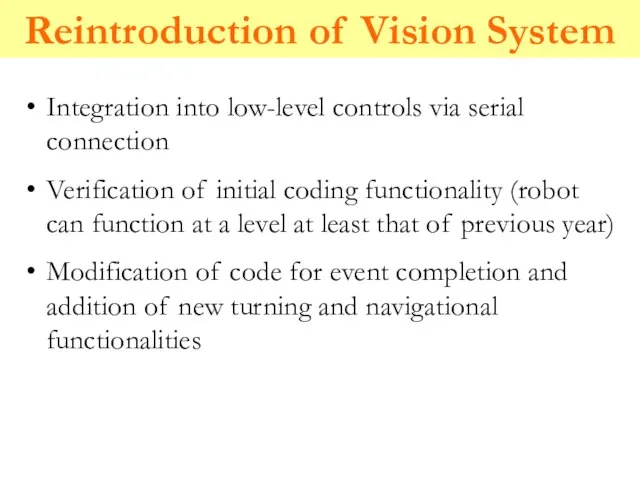
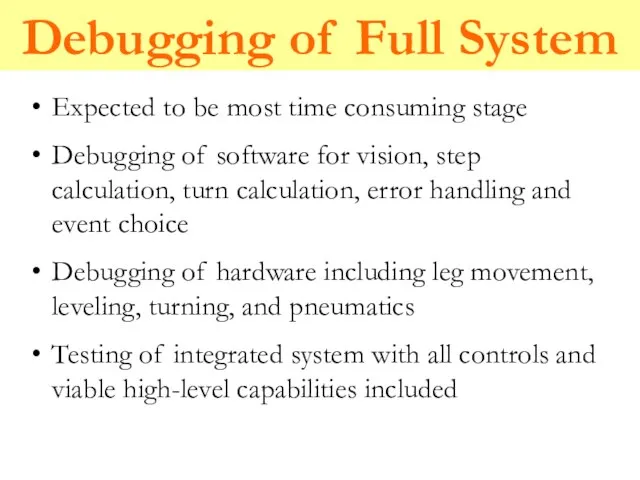

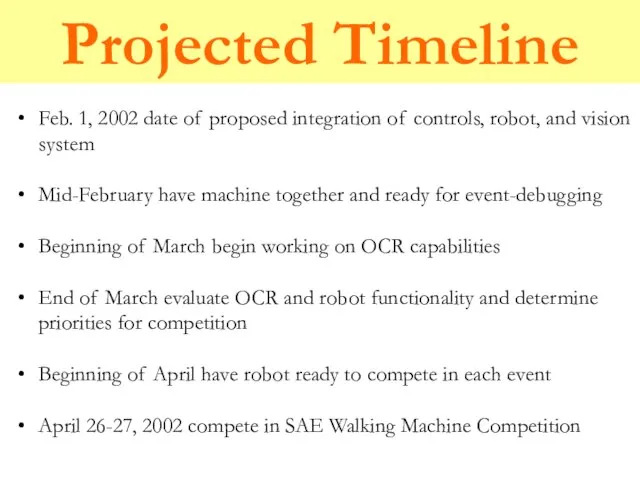
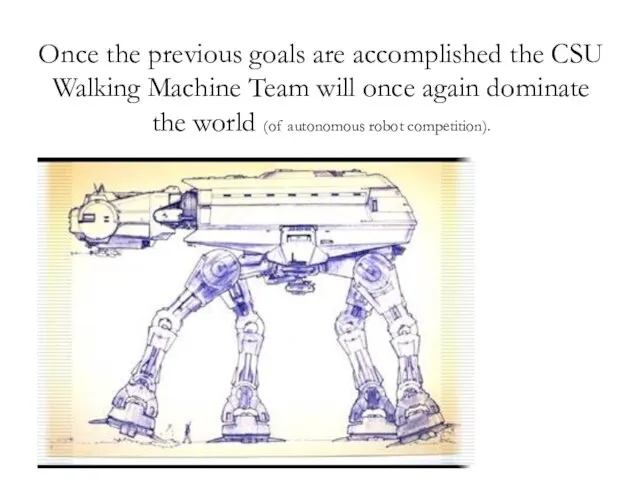
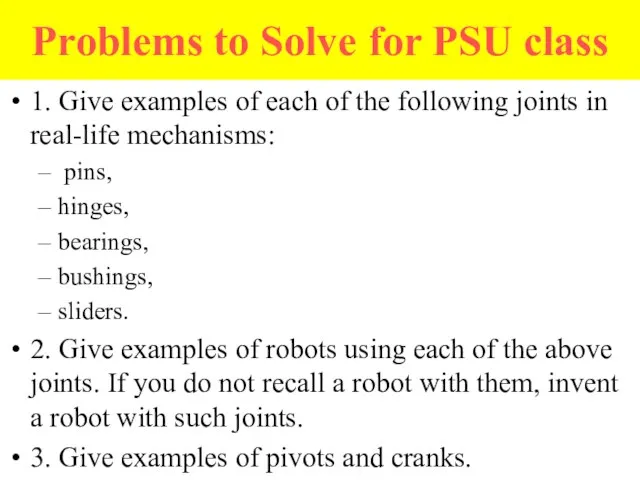
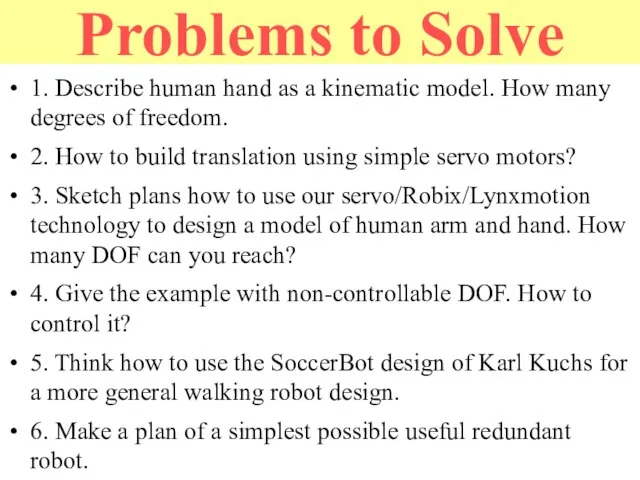
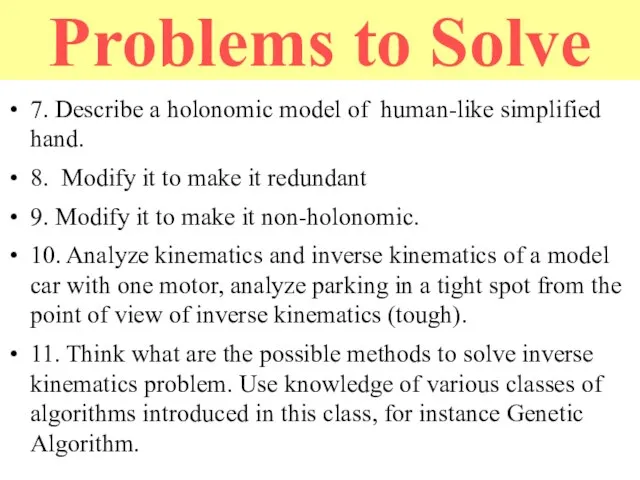
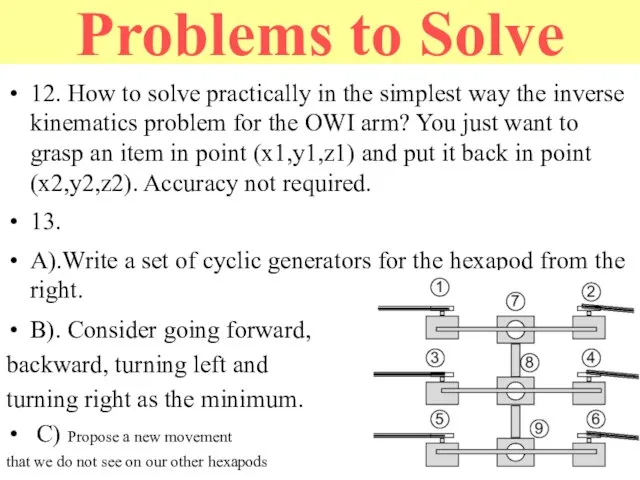
 Язык изображения
Язык изображения Окно в Париж 7 мая- 6 июня Регистрация 200 тенге Новички Зарегистрируйся в указанный период, размести заказ на 100 и более ББ в течение 21
Окно в Париж 7 мая- 6 июня Регистрация 200 тенге Новички Зарегистрируйся в указанный период, размести заказ на 100 и более ББ в течение 21 Безударные гласные в корне слова, проверяемые ударением. Валентина Жуковская 2009. - презентация
Безударные гласные в корне слова, проверяемые ударением. Валентина Жуковская 2009. - презентация О законодательной поддержке инновационной деятельности в России
О законодательной поддержке инновационной деятельности в России The difficulties of translating business letters and agreements
The difficulties of translating business letters and agreements Правила безопасного обращения с бытовыми электроприборами
Правила безопасного обращения с бытовыми электроприборами ПУТИ ВНЕДРЕНИЯ СИСТЕМЫ УПРАВЛЕНИЯ КАЧЕСТВОМ В МЕДИЦИНСКОЙ ОРГАНИЗАЦИИ
ПУТИ ВНЕДРЕНИЯ СИСТЕМЫ УПРАВЛЕНИЯ КАЧЕСТВОМ В МЕДИЦИНСКОЙ ОРГАНИЗАЦИИ Закон Паскаля
Закон Паскаля Этикет приветствий и представлений
Этикет приветствий и представлений Николай Рубцов 1936 - 1971
Николай Рубцов 1936 - 1971 Food shopping
Food shopping Гимнастика
Гимнастика Выставка картин художника Анисимова Владимира Тимофеевича
Выставка картин художника Анисимова Владимира Тимофеевича Агентство APRель
Агентство APRель Методы и приемы, способствующие развитию интереса к урокам русского языка(методическое объединение)
Методы и приемы, способствующие развитию интереса к урокам русского языка(методическое объединение) Аттестационная работа. Создание кукольного театра Рукавичка
Аттестационная работа. Создание кукольного театра Рукавичка «Создание ароматических композиций из эфирных масел в условиях малой химической лаборатории»
«Создание ароматических композиций из эфирных масел в условиях малой химической лаборатории» Формы культуры
Формы культуры S
S Областной конкурс перспективных проектов в сфере информатики и вычислительной техники
Областной конкурс перспективных проектов в сфере информатики и вычислительной техники Музыкальная аптечка
Музыкальная аптечка Современные средства поражения
Современные средства поражения Презентация на тему Мутация
Презентация на тему Мутация Засоби навчання
Засоби навчання Нобелевские лауриаты по физике
Нобелевские лауриаты по физике Роль спортивных секций в работе школы
Роль спортивных секций в работе школы Модель внутришкольного управления качеством образования
Модель внутришкольного управления качеством образования Открытка из Франции
Открытка из Франции